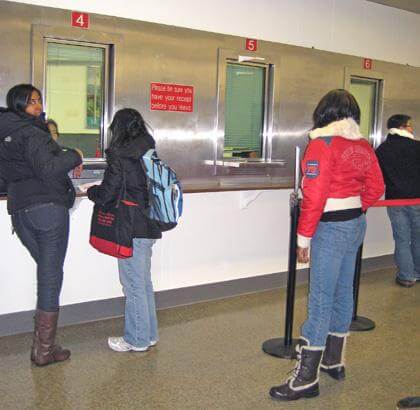By Ivan Pereira
On the Queens College and St. John’s University campuses, many students are fretting that they will have to dig deeper into their wallets because financial aid experts say lenders and scholarship providers are beginning to give out less.
“Most people I know take out student loans,” said out−of−state Queens College freshman Dasi Fruchter, 19, who uses a loan to pay for rent. “They’re worried about how their parents … will be able to pay it back.”
Although the economic outlook is grim, financial aid experts at both schools said they were optimistic that students could weather the storm with long−term planning.
Jorge Rodriguez, the associate vice president of financial services at St. John’s, said his office has been getting a lot of visitors in the last couple of months because many private lending institutions are going out of business and some are transferring the borrower’s debt to another institution.
A St. John’s senior who would only identify herself as Sarah said she was nearly blocked from registering for spring semester classes because the company where she had taken her loan out in the fall folded.
“All of a sudden there was a hold on my account and I had no idea what was going on,” she said. “I had to put the whole three grand on my credit card.”
To avoid similar problems, Rodriguez said parents and students shop around the loan market through the Internet, financial aid offices and banks for loans that can cover tuition and other school expenses for a full year. He also said lenders will be very picky as to who gets their funds and will take a hard look at a student’s credit score before approving the loan.
“If you get approved, take as much you can now because you don’t know how much your credit will change,” he said.
Rodriguez also noted that St. John’s, a private school, doles out millions for financial aid with nearly 95 percent of St. John’s students receiving some sort of financial help in the 2006−07, school year, according to the private university’s Web site.
At Queens College, a public school, where approximately 38 percent of students receive government grants and loans, learners are concerned about financial aid but in a different way. Rena Smith−Kiawu, director of financial aid at the Flushing campus, said that thanks to CUNY school’s government funding, her students not only have lower tuition than some of the city’s other colleges, they also have access to government subsidized loans.
While private loans come with the risk of folding or fluctuating interest rates, Smith−Kiawu, who has worked in the office more than 30 years, said New York has never denied students who attend public colleges help to pay for their education.
She was confident that Albany’s actions to reduce its $12 billion deficit would not affect the state aid. “The state has not said that it will be discontinued as of now,” she said of the subsidized loans.
Hope may come from the federal government. On Tuesday, U.S. Treasury Secretary Henry Paulson announced the Treasury and Federal Reserve have approved a plan to create a special program that would buy $200 million worth of consumer and small business loans, including student loans.
The advisor said she has seen more students come into Queens College’s financial aid office to inquire about the loans. Several young adults on campus said they are worried how a possible increase in tuition will affect their finances.
Gov. David Paterson has said that his budget may call for a 22.5 percent increase in the annual $4,000 price tag charged for attending four−year CUNY schools.
“I’m afraid if the tuition goes up,” said Queens College sophomore Leah Athanasiadas, who has a Peter Vallone Scholarship.
As for paying off the debt, both Rodriguez and Smith−Kiawu said it would depend on the students’ financial situation once they graduate. For those who might not have the finances to pay off their interest, Rodriguez said many lending companies are willing to renegotiate the terms of the college loan with the students even before they graduate.
Some offer assistance through forbearance, which gives the borrower a six−month grace period after graduation or an income contingent, where the loan payment periods are extended depending on income.
“They have so many options,” Rodriguez said of students. “The lenders don’t want a student to go into default.”
Rodriguez said parents and students applying to college now should immediately get to work on their tuition payment plan. The money and scholarships would be more available earlier than later, according to the adviser.
Many students agreed. St. John’s junior Matthew Streppone, 19, said he is not concerned about paying off his debts because he and his parents have mapped out a plan to make his payments efficiently.
“I’m going to have to pay back right away, because if I don’t, the interest rate will go up and I’ll have to pay more,” he said.
Reach reporter Ivan Pereira by e−mail at ipereira@timesledger.com or by phone at 718−229−0300, Ext. 146.



































